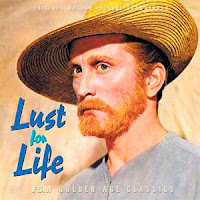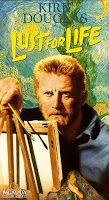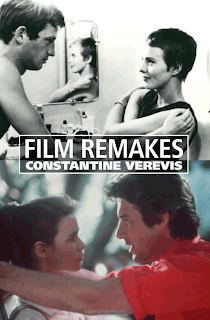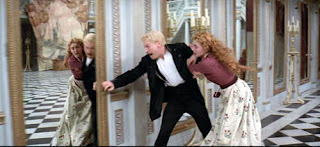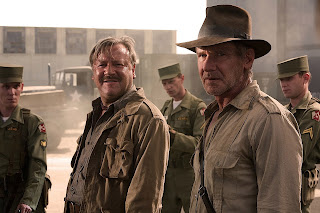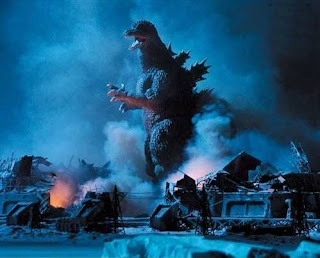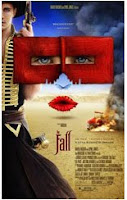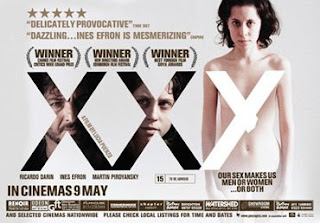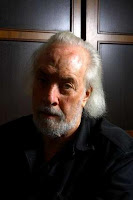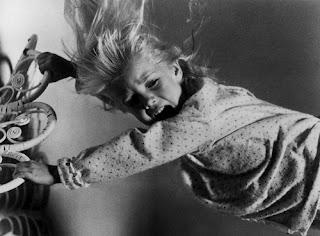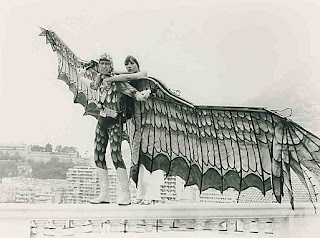On January 17, 2007, Indy IV screenwriter, David Koepp, said, “I’m going to get my ass handed to me on some level, even by my fellow filmmakers or the audience.”
And so on this day, May 26, 2008, I, Mystery Man, will now officially hand David Koepp his ass:

(That’s my butler – Baremore. And I'm not even going to explain how we got David's ass. Hehehe…)
--------------------------------------
50 Flaws of Indy IV
** Total Spoilers **
1) Indy – The problems begin with Indy. Manohla Dargis suggested in her review that the film was a half-hearted effort on the part of Spielberg because he seemed bored with the material. How does one get that impression from a film? I would submit to you that the entire enterprise felt half-hearted simply because Indy was under-motivated. An Indiana Jones film does not hang its hat on the McGuffin but rather Indy’s motivation. The McGuffin doesn’t matter. What matters is how important that McGuffin is to Indy. If Indy wants an artifact more than anything, then the audience will want him to have it more than anything. It’s that simple. Indy should've gone to get the skull because HE wanted to get the skull, and was always fascinated by the skull, and couldn’t wait to get his hands on it - NOT because Oxley and some woman named “Mary” were kidnapped. We don’t know who Oxley or “Mary” is so we don’t really care, and the adventure begins on a half-hearted, uninspired note. We cared in Raiders because Indy WANTED the Ark. We cared in TOD because we saw the dying village and Indy WANTED to get the stones for them. We cared in LC because we met his Dad, albeit briefly, in the opening flashback sequence before we learned about his disappearance. Some professor and some woman we never knew and haven’t seen is missing? Who cares?
2) Indy said that he and Oxley “used to be obsessed” about the skulls. A more compelling motivation would’ve been, very simply, that Indy was STILL obsessed about the skulls, that it was his latest and greatest passion, that he would love to find one, and he takes off to get it. But here, his motivations are muddled and confusing. Does he want to save Oxley and Mutt’s mom as a courtesy to this kid he's never met before or does he want the skull? Does he even care about the skull?
3) Another ridiculously under-motivated moment with Indy came right before the Third Act climax. After having gone over those 3 waterfalls, Indy tells the gang that he has to return the skull. Why? “Because it told me to.” How half-hearted and ridiculous is that? Are you kidding me? Indy should’ve WANTED to return the skull because HE personally wanted it to happen. Period. All of this under-motivation (or confusing multiple motivations) of Indy points to a bigger problem and that is, the filmmakers themselves were never fully committed to their own McGuffin. It's as if they brought back Marion as an excuse to have an adventure despite the McGuffin, because they were too embarrassed about it. It's almost as if Spielberg is purposely trying to distance himself from the younger Spielberg who believed in aliens and made a movie about a man who left his wife and children to fly away on an alien spaceship. Hey, look. If you're going to tell an Indiana Jones story, you have to be fully committed to your McGuffin regardless of what it is. Indy has to care deeply about that McGuffin. He has to WANT IT. BADLY. If Indy's fully committed to wanting an artifact, the audience will be, too, and happier when they walk out of the theater.
4) The Warehouse - If Indy knew what the Russians were looking for and how to find it, why did he later ask the FBI agents what was in the box? If he didn’t know what was IN the box, how did he know the box had magnetic properties? He does sorta explain this dilemma in the interrogation scene. He tells the FBI agents a tale about being thrown on a bus in the middle of the night, seeing mutilated bodies, and being told not to say anything. He revealed nothing about his experience with the box and knowing about its properties. The fact that we even have to endure a convoluted piece of verbal exposition about what happened in order to explain how Indy knew about a box and its magnetic properties without knowing its contents is weak screenwriting.
5) Skulls - Correct me if I’m wrong. Indy said in the diner that there were 13 skulls. He found one in Peru, and Spalko obtained another one at the warehouse, right? But there were already 12 in the chamber that needed 13. That's 14 skulls. Then Spalko says later that more skulls were found in Russia and other places. Then why did she need the one in the warehouse? What was the point of the warehouse sequence? What was the point of Indy saying that there were only 13 skulls? How did they know that the skull in the warehouse WASN’T the important 13th skull that needed to be returned? Indy films were a lot of things, but confusing was never one of them.
6) FBI - The subplot with the FBI went unresolved and had nothing to do with the main plot. You would’ve thought that we had that interrogation scene with the FBI agents because the U.S. government would continue to spy on Indy around the world and that this would’ve played a part in the Third Act climax after which Indy’s name would be cleared. But, no. Those scenes were pointless except to perhaps make statements about government witch-hunting, which has already been made more brilliantly in other films. Indy’s name is, presumably, cleared in the end, because he’s reinstated at the college, but we never know how or why this happened. A horribly under-developed subplot.
7) And let me also add that the FBI agents and the General are 3 wasted characters, and that's sloppy writing. What’s the point of this subplot if we’re only going to see these characters once? At least the government guys made a re-appearance at the end of Raiders.
8) Mac - I question the point of Mac’s character. The idea of a double-crossing sidekick is great fun, but he was never put to good use. In fact, they totally gave the game away in the very beginning with Mac's betrayal at the warehouse. He turns on Indy before we ever had a chance to get to know the guy. Hence the quick, yet forced dialogue outside the warehouse about their long history together. Forced exposition like that does not help the surprise of Mac’s betrayal. Spending time with a character is what gives us the emotional punch of a betrayal. Not only that, Mac turns on Indy in the least dramatic moment. The Russian army never needed Mac to save them. Of course, Mac HAD to turn on Indy in the warehouse sequence so that, in the next few scenes, Indy would be under suspicion by the FBI for a subplot that never gets fleshed-out or resolved. They should've saved the twist of Mac’s betrayal for the ending. As it is, the scenes with Spalko following the red-light blinking thingees were boring because we KNEW Mac was leaving them. Where's the surprise and tension in that?
9) Why was Mac in Peru? Presumably, it’s a conspiracy of the most absurd kind. I think I understand. Try to follow me. The Russians let Marion mail the letter to her son with the instructions to take the letter to Indy so that he will go on the hunt to obtain the 13th skull. And the Russians knew that Indy took on this challenge because they saw Mutt with Indy in the diner, and thus, they sent Mac to Peru to follow them. But Mac’s already betrayed Indy. That makes it an even bigger risk to the Russians to have him there. Why not send some anonymous spy? Why was Mac even in Peru? Didn’t he get paid off for the warehouse job? Shouldn’t he be on holiday? Since when did Russians pay?
10) Funny that Mac didn’t die in that crushing head-on collision in the warehouse, which involved THREE vehicles when that third truck rammed into back of what was Indy’s jeep.
11) Diner Scene - the exposition in the diner scene was the worst in the franchise. This was the most amateurish rock-bottom handling of exposition that could have been written. It was two talking heads in a diner. That's it. Remember how visual the exposition was in the Raiders setup with the big book and the chalkboard and the talk about the Well of Souls? That's great exposition. That was exciting! In TOD, we had the visual of the dying village. In LC, at least we had the visuals of dad's journal. Here, it's just two talking heads. And Spielberg had to add those visual flourishes of Mutt toying around with the coke and beer to keep the scene from being boring and visually lifeless. One of the bedrock principles of screenwriting: show, don’t tell.
12) There was also too much exposition in the diner scene. We had the rather convoluted and confusing backstory of Oxley, how Oxley’s important to Mutt, the kidnapping of Oxley, the kidnapping of his mother, the letter, and also heaping amounts of exposition from Indy about the skulls. It was too much. Indiana Jones films were a lot of things, but they never had to do a lot of explaining about anything. It would’ve been much easier if he had said very simply, “My Mom’s Marion Ravenwood, and she’s missing.” This would’ve given Indy a stronger motivation that could’ve excited audiences. We would’ve anticipated this great reunion, and we wouldn’t have had to listen to chunks of exposition to get around a surprise everyone saw coming since the day Shia’s casting was announced. Besides, even if some in the audience were actually surprised by her return, how many times are you going to be surprised by that twist? Only once.
13) Indy tells the Crystal Skull story to Mutt in the diner almost dismissively (“It's just a story, kid”) even though he just helped the Russians find one in the warehouse… in a box that he didn’t know about but somehow knew it had magnetic properties.
14) What was the point of the scorpion sting on Mutt's hand? Shouldn't that have led to something else? Or a setup to a joke of some kind later? By the way, David, scorpions STING, they don't BITE. I seriously doubt Indy would've made that little verbal mistake.
15) Discovering the Skull - Two problems with Indy finding the skull. First, you make the whole experience and joy of discovery less special (or not special at all) if it’s a tomb that Indy doesn’t discover for the first time and if it’s an artifact that Indy isn’t the first to find. Here, the tomb's already been raided, the artifact was found, taken, and put back for Indy to find later. That’s ridiculous. That pulls the rug out from all the fun of watching Indy do what he does best.
16) The second problem is that the discovery of the skull was too simple and too easy. He handed a corpse to Mutt and flipped up some fabric. Are you kidding me? Consider the past films and all the great care that went into the revealing of the all-important McGuffin, which was always made as special as possible for the audience.
17) Consider how the metal objects of the warehouse trailed behind the skull, which was wrapped up inside a lead container inside a wooden box. If the skull was behind the corpse’s head in Peru, why wasn't all the gold lying RIGHT NEXT to the corpse all over the head?
18) How did Oxley, of all people, get past the graveyard guardians? Plus, who did they work for? And who did their wardrobe and make-up?
19) Dialogue - WAY too much confusing dialogue in Act Two while they were searching for Oxley. There were too many double-meanings of words, which is beneath the caliber of an Indy film. I didn't understand much of it on my first viewing. The scene in the tomb should’ve ended almost immediately after they found the skull, but they just kept talking and talking. That was a bad pacing misstep.
20) The skull looked like cheap plastic filled with Saran Wrap. There was no discernible rhyme or reason to its properties except that they were carefully designed to save Indy whenever he was in trouble.
21) Irina Spalko - She was the worst and weakest of the villains. She wasn’t even as ruthless as Julian Glover. Koepp cock-blocks every opportunity to make her a great villain. First, he should've established early just how BAD she really is. The worst thing she ever did was whip out her sword. I would’ve been happier if, instead of Mac betraying Indy in the warehouse, Spalko kills Mac to prove that she meant business. The fact that Spalko couldn't communicate with the skull was another misstep, in my opinion. Her mental connection to the skull would've raised the stakes and turned her into a more dangerous antagonist. Also, why make Spalko a psychic if A) she can’t even read Indy’s mind and B) nothing else develops from it? Her psychic abilities, I guess, was her motivation to obtain the skull’s power of mind, but she was so weak as a villain that I never felt she deserved what she got in the end. (I get the sense that they made her a soft villain so they wouldn’t offend today’s Russians, but to make her weak would be even more offensive, would it not? Besides, there is nothing worse in an Indy film than an under-motivated protagonist and a soft villain.)
22) Marion - We never got the sense that Marion was ever in real danger. Consider how quickly and simply Marion was in danger in the bar scene in Raiders.
23) I never once believed that Marion would not have told Indy about their son. The only reason she didn’t tell him was because a contrived plot forced her to do so and we can have a special moment in a sandpit.
24) Why was Indy helping the Russians? Wouldn't he have told them one thing to send them on the wrong path while he goes off to do something different? Wouldn't that be more in his character? The fact that Indy was asking for help when only the Russians were around (and they always complied) just made them even LESS formidable as foes. Could you imagine Indy asking the Thuggees for help?
25) Mutt - I never once believed that Mutt, a supposedly tough 50's teen rebel, would've been so emotional about Oxley – even more so than for his own mother who's in just as much danger as Oxley.
26) The fact that Mutt was able to surprise a trained Russian army by pushing over a table, pushing them back with the table, and throwing down a lantern was beyond implausible.
27) Why did Indy tell Oxley to “get help” when he and Marion were in the sandpit? The only humans within a square mile were armed Russians actively searching for Indy. And Mutt already went to get help. Indy would’ve known better. Besides, they were surrounded by trees. Why didn't they just grab a nearby branch? I’ll tell you why. Because the screenplay called for a contrived slapstick moment with a snake that was too forced and unbelievable to get real laughs.
28) Early Reviewers - I’d like to give a shout-out to ShogunMaster who wrote that scathing early review. He took a lot of heat for that in the media. David Poland at Movie City News described him as “one idiot.” There were actually 3 reviews, David. Try to keep up. The thing is, ShogunMaster was right. All of his complaints about lack of tension were not only spot on but also echoed by many other top critics, including Robert Wilonsky, Joe Morgenstern, James Berardinelli, and the great Manohla Dargis who said she was “bored out of her mind.” Here’s a perfect example of this film's lack of tension. How can there be any tension leading up to the Third Act when Indy has the McGuffin in his possession and he’s doing what the Russians want him to do (without forcing him to do it) and he’s also doing what the skull wants him to do? What the hell does Indy want? When we get into the chamber, he strangely changes his mind when Spalko puts the skull on the alien’s body. If anything, the Russians should’ve obtained the skull in the chase sequence, captured Indy and the gang, and they all marched up to the chamber together. Indy could’ve known what would happen if the skull is returned, DIDN’T want to see that happen, and tries to stop Spalko from doing it. THAT, my friends, creates TENSION.
29) Nothing, and I mean NOTHING, about the Third Act climax and the aliens made any sense to me. How did the 13 become one? Why do they become one? What was the “gift” exactly? Melting Spalko?
30) I actually didn't like the exchanges between Marion and Indy. It was all too angry, on-the-nose, and not much fun for me. Marion’s return was just a ridiculously contrived fanboy concept, and I believe Jeb Stuart’s wedding (and the surprise appearance of Marion and Willy in a bar afterwards) would’ve played better with audiences.
31) So Indy, Marion, and Mutt are prisoners in the back of a truck, which of course, they manage to escape from AGAIN by suddenly kicking everybody. Question - why would Russians have a bazooka stored in a truck transporting prisoners?
32) The Chase - Ebert had a funny observation: “We get such sights as two dueling Jeep-like vehicles racing down parallel roads. Not many of the audience members will be as logical as I am and wonder who went to the trouble of building parallel roads in a rain forest.” Actually, Ebert’s wrong. There shouldn't have been ANY roads, because the sequence began with that monster vehicle cutting up the rainforest and paving the way for the convoy behind it. After Indy blew it up, they should've been on foot or turned the truck around and went back.
33) Nearly everyone made this complaint and it’s true - excessive, bloated CGI. I hated those stupid prairie dogs. The "big damn" CGI ants would've never worked. In Raiders, you felt tension with Indy fighting around that plane because it was a real, physical plane. You'll never feel that same kind of tension with CGI ants, which frankly betrayed years of promises to fans about no CGI.
34) No blood. Anywhere. Just a bit in the Soviet soldier's mouth before he toppled into the ants. That was it. Hardly any bullet holes in the dead Indians and no blood after the soldiers got gunned down in the beginning. This was the most cartoonish, fake, sanitized Indiana Jones film ever made and one that should’ve been PG instead of PG-13.
35) The sword fight between Mutt and Spalko was pointless and failed to advance the story in any way. Mutt was given what amounts to a razor burn and that’s it. Mutt’s talent for sword-fighting was fed to us via bad verbal exposition. If a character has a particular skill that the audience needs to know about, then that skill better be used to advance the story in some meaningful way, not so that we can have a 10-second sword fight on top of two moving cars that has no affect on the outcome of this giant “tent pole” chase sequence.
36) Shia swinging from vines was the dumbest idea in not only the entire Indiana Jones franchise but also the Spielberg canon. It’s worse than the high bar crap in Lost World, which by the way was also written by David Koepp. But even worse than that is the simple fact that Indiana Jones did NOTHING in the big chase sequence. All the action was handed to Mutt. Tell me: whose movie is this? Indy’s or Mutt’s?
37) Oxley - What was with the funny-sounding rod that Oxley was playing with the first time we see him, which is presented to us as if it has some kind of significance and then is quickly forgotten?
38) Here's Ebert again: “At his advanced age, Professor Oxley tirelessly jumps between vehicles, survives fire and flood and falling from great heights, and would win on 'American Gladiator.' Relationships between certain other characters are of interest, since (a) the odds against them finding themselves together are astronomical, and (b) the odds against them not finding themselves together in this film are incalculable.”
39) I also wholly agreed with James Berardinelli: “Unfortunately, not only is the level of tension at an all-time low but the choreography is dubious. The film can't keep track of all the characters so one car disappears for half the chase only to reappear at a critical juncture near the end. The movie contains its share of other action scenes that, while less lavish or extensive, are no more thrilling.”
40) So those natives were just plastered into the walls, waiting for someone to come along for the last 500 years? The idea was too similar to the crazy protectors of the graveyard in Peru. The entire discovery of the skull should’ve been completely scrapped and re-done.
41) There were jokes about Indy's age, but his fights were treated as if he was still young. So which is it? Is he old or is he young? Don’t bones get more brittle with age? One of the charms of Indy in the past is that the filmmakers allowed him to show pain. But in this film, he takes more abuse than he ever did in the three previous films, doesn't show any pain whatsoever, and yet, he's much OLDER.
42) Way too many characters: Indy, Mutt, Marion, Mac, and Oxley.
43) We were frequently ahead of the story (when we weren't confused) such as “Mary” being Marion Ravenwood or Mutt being Indy’s son or that Indy will win the fight with the Russian soldier who will fall into the ants, or frankly, the mysteries about the skull itself.
44) The spaceship taking off lacked any sense of wonder. Nothing Spielberg could give us in that sequence will ever compare to the emotional impact of E.T. or the stunning visuals of Close Encounters. I blame Lucas for putting Spielberg into the position of giving the audience an impossibly unsatisfying ending any way he approached it.
45) “It's the space between the space” might actually be worse Third Act dialogue than “Illumination.”
46) I don’t know about your crowd, but when Shia was getting ready to put Indy's hat on, people in my theater started BOOING.
47) You know it’s bad when even John Williams turns in a lame score.
48) Should I even mention how joyless and unfunny it was? I’d recommend that Koepp reads Mel Helitzer’s Comedy Writing Secrets.
49) By my count, Indy should’ve died 168 times.
50) And finally, they should’ve turned to me for the writing duties.
Hehehe…
[I'd like to thank Erin, Joel, anonymous, Octavio, Mickey Lee, Nic, Purpletrex, James, Pat, and Kevin Lehane for their thoughts. -MM]



